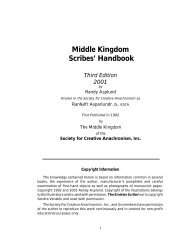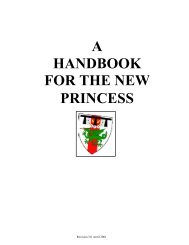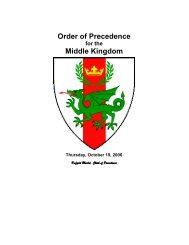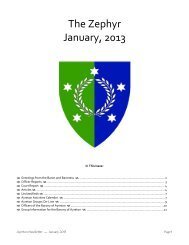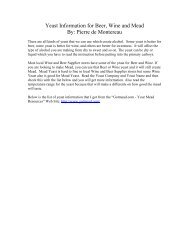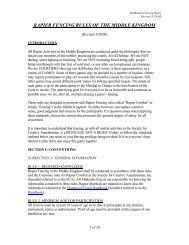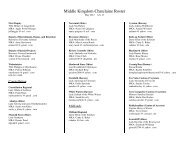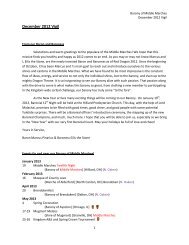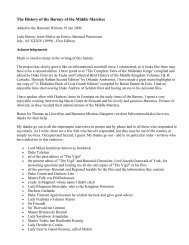Rapier Marshals Handbook - Midrealm / Middle Kingdom
Rapier Marshals Handbook - Midrealm / Middle Kingdom
Rapier Marshals Handbook - Midrealm / Middle Kingdom
Create successful ePaper yourself
Turn your PDF publications into a flip-book with our unique Google optimized e-Paper software.
2.2 MIDDLE KINGDOM STANDARDS FOR WEAPONS & PARRYING DEVICES<br />
Rev. 2.0<br />
20 th of July, A.S. XXXV<br />
2-7<br />
2.2.1 GENERAL REQUIREMENTS<br />
A. BLUNTNESS<br />
Points, edges and corners on all equipment should be nominally blunt.<br />
B. STURDINESS<br />
All equipment must be able to safely withstand combat stresses.<br />
C. PROHIBITED EQUIPMENT<br />
Any equipment that has small rigid openings large enough to admit a rapier tip will not be used against fencingtype<br />
rapiers (e.g., small holes in bell guards, small openings in cage or swept hilts, any design which has acute<br />
angles where a blade could easily be wedged and bent). Knuckle bows ARE DEEMED SAFE for use with<br />
fencing-type blades.<br />
Equipment that is designed to break a blade or damage other equipment is prohibited.<br />
2.2.2 WEAPONS<br />
A. PERMITTED BLADES<br />
The <strong>Middle</strong> <strong>Kingdom</strong> uses 2 classes of rapier blades; fencing-type rapiers and heavier-type rapiers.<br />
The edges of all blades must be blunt.<br />
Fencing-Type <strong>Rapier</strong>s<br />
- Epees<br />
- Double-wide Epees<br />
Epees may only be used at practices and at out of kingdom events. They are not to be used in any<br />
tourney or melee within the <strong>Middle</strong> <strong>Kingdom</strong>. Epees must have a c-curve (If the groove is on the top<br />
of the blade, the blade curves smoothly away down towards the ground).<br />
Heavier-Type <strong>Rapier</strong>s.<br />
- Schlaeger (diamond and oval) blades<br />
- Del Tin practice rapier blades<br />
- Del Tin bated rapier blades<br />
- Scottie Diamond Schlaeger blades<br />
- Zamorano rapier blades<br />
- Starfire rapier blades<br />
Legal daggers:<br />
- Flexi-type Daggers<br />
- Scottie Flexible Dagger Blades<br />
- Safe-Flex Mark 2 Dagger Blades<br />
B. STANDARD AND NON-STANDARD LENGTH BLADES<br />
A typical rapier blade (excluding the tang) measures between 34 inches and 36 inches long. A typical dagger<br />
blade (excluding the tang) measures between 12 inches and 18 inches long.<br />
C. MANUFACTURE OF BLADES<br />
Blades must be manufactured by commercial suppliers.<br />
D. ALTERATION OF BLADES<br />
When altering the blade or tang of the weapon, avoid any action that could alter its temper, flexibility or<br />
durability. Hammering or excessive heating by grinding or cutting could weaken the blade.<br />
E. FLEXIBILITY OF BLADES<br />
Blades must be reasonably flexible. Blade flexibility may be tested at any time at the discretion of the marshals.<br />
If doubt exists about a weapon's flexibility, hold the weapon parallel to the ground supporting the handle against<br />
a table or bench, if necessary. Hang a 3-ounce weight (85 grams) just behind the tip. If the blade is18 inches in<br />
length or less (excluding the tang) and flexes more than 1/4 inch (6 mm) or more, the blade is sufficiently<br />
flexible. If the blade is greater than18 inches in length (excluding the tang) and flexes more than 1/2 inch (12<br />
mm) or more, the blade is sufficiently flexible.<br />
F. TIPPING OF BLADES<br />
Heavy-type rapiers must be tipped with rubber or plastic tips measuring no less than 1/2 inch in diameter. A<br />
metal washer or a strip of four-ounce leather or the equivalent, must be placed between the tip of the blade and<br />
the inside of the rubber/plastic tip.<br />
Fencing-type rapiers and daggers must be tipped with rubber or plastic tips measuring no less than 3/8 of an<br />
inch in diameter. If the tip is not rounded, a metal washer or a strip of four-ounce leather or the equivalent, must<br />
be placed between the tip of the blade and the inside of the rubber/plastic tip.<br />
On all blades, the rubber or plastic tip must be firmly taped in place (colored duct tape is recommended). The<br />
tip and the last two inches of the blade shall be taped in a bright color that contrasts with both the tip and the<br />
blade so that a broken blade or the loss of the tip will be readily apparent. The striking portion of the tip shall<br />
not be covered in tape so that it may be inspected for excessive wear.<br />
SECTION 2<br />
EQUIPMENT STANDARDS<br />
Change 1 (replace 1-6, 1-7, 1-9, 2-3, 2-7, 2-8 & 2-9, remove pages 1-8 & 1-10), - Effective 5/1/02



